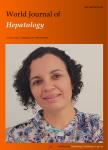Virological response and resistance mutations to NS3/4A inhibitors in hepatitis C virus-human immunodeficiency virus coinfection
Virological response and resistance mutations to NS3/4A inhibitors in hepatitis C virus-human immunodeficiency virus coinfection作者机构:Infectious Diseases Department Archet Hospital Centre Hospitalier Universitaire Virology Laboratory Archet Hospital Centre Hospitalier Universitaire Internal Medicine Department Archet Hospital Centre Hospitalier Universitaire
出 版 物:《World Journal of Hepatology》 (世界肝病学杂志(英文版)(电子版))
年 卷 期:2015年第7卷第18期
页 面:2177-2183页
学科分类:1004[医学-公共卫生与预防医学(可授医学、理学学位)] 100401[医学-流行病与卫生统计学] 10[医学]
基 金:Abbvie Bristol-Myers Squibb Gilead Sciences Inc Janssen Merck
主 题:Telaprevir Boceprevir Hepatitis C virushuman immun
摘 要:AIM: To evaluate virological response to telaprevir or boceprevir in combination with pegylated interferon and ribavirin and resistance mutations to NS3/4A inhibitors in hepatitis C virus-human immunodeficiency virus(HCV-HIV) coinfected patients in a real life setting. METHODS: Patients with HCV genotype 1-HIV coinfection followed in Nice University Hospital internal medicine and infectious diseases departments who initiated treatment including pegylated interferon and ribavirin(Peg IFN/RBV) + telaprevir or boceprevir, according to standard treatment protocols, between August 2011 and October 2013 entered this observational study. Patient data were extracted from an electronic database(Nadis®). Liver fibrosis was measured by elastometry(Fibroscan®) with the following cut-off values: F0-F1: 7.1 k Pa, F2: 7.1-9.5 k Pa, F3: 9.5-14.5 k Pa, F4: ≥ 14.5 k Pa. The proportion of patients with sustained virological response(SVR) twelve weeks after completing treatment, frequency and type of adverse events, and NS3/4A protease inhibitor mutations were described. RESULTS: Forty-one patients were included: 13(31.7%) patients were HCV-treatment na?ve, 22(53.7%) had advanced liver fibrosis or cirrhosis(Fibroscan stage F3 and F4); none had decompensated cirrhosis or hepatocellular carcinoma; all were receiving antiretroviral treatment, consisting for most them(83%) in either a nucleoside reverse-transcriptase inhibitor/protease inhibitor or/integrase inhibitor combination; all patients had undetectable HIV-RNA. One patient was lost to follow-up. SVR was achieved by 52.5% of patients. Five patients experienced virological failure during treatment and four relapsed. Seven discontinued treatment due to adverse events. Main adverse events included severe anemia(88%) and rash(25%). NS3/4A protease mutations were analyzed at baseline and at the time of virological failure in the 9 patients experiencing non-response, breakthrough or relapse. No baseline resistance mutation cou



